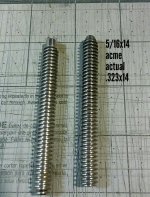That all depends on a lot of factors. If it was a single machinist making the screw (doubtful, most are rolled or formed), then it is on him to make a part to spec and there would be a record on how many parts he didn't make to spec, eventually leading to promotions, demotions, firing, etc..
In the case of screws, they are likely formed and not machined. The internal QA department would hopefully catch parts before they leave and fix whatever problems arise.
In the case of very high tolerance screws, it is a bit different. I know a decent amount about Bosch Rexroth rolled ballscrews, so I'll use that as an example. When BR makes a run of rolled ball screws, they will run the whole batch and inspect after. They then sell these screws in different precision grades at vastly different costs. They do this because the difference between the highest and lowest grades is pretty small, and there are so many factors that can change, causing enough variance to move a screw from one class to another. They basically always try to create the most precise grade of screw, but they know that only a small percentage are going to meet the classification. Many others will be slightly lower, others lower still, and a few will fail altogether.
Ground ballscrews and rollerscrews are a completely different story...and the price reflects it.
